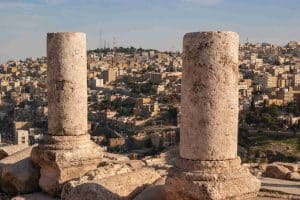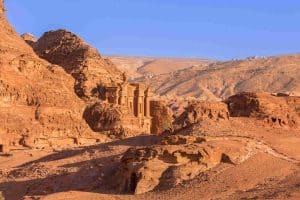The Treasury of Petra is the most famous monument in this rock-carved city, which was the capital of the Nabatean Empire. But even though you may have seen it thousands of times in photographs, there may be some details you haven’t noticed yet. Here we share these curiosities… which you can verify if you take your trip to Jordan with our agency.
#1. The Treasury of Petra was a royal tomb
Although there is no unanimous agreement among experts, the most accepted hypothesis is that the Treasury of Petra was the tomb of King Aretas IV, a monarch during which the Nabatean Empire reached one of its peaks in the 1st century AD.
#2. The reason behind its name
The Treasury of Petra is called that despite its actual function, as we have seen. According to popular Bedouin belief, the small tholos (circular structure with a dome, located on the facade) hid a treasure from the pharaonic era. There are still visible bullet holes, likely from Ottomans or Bedouins, who may have intended to discover if this assumption was true.
#3. A good place for the Holy Grail
Many are familiar with this monument precisely because Indiana Jones was searching for another treasure here in “The Last Crusade.” In this case, it was the Holy Grail, the chalice used by Jesus Christ during the Last Supper, and undoubtedly one of the most sought-after relics in Christianity. So, Steven Spielberg did not hesitate to place its location in such a solemn place as this.
#4. So, what’s inside?
The information mentioned earlier leads us to another question. So, what is inside the Treasury of Petra now? Currently, it only consists of a small vestibule, devoid of decoration or furniture, which likely housed the tomb of Aretas IV. However, there are no upper floors, and the mentioned urn is made of solid stone, so it doesn’t hide anything either.
#5. An original Hellenistic style
From a purely artistic perspective, the Treasury of Petra is a very interesting and innovative work. It can be classified as ‘Hellenistic’ as it is inspired by the late and flourishing historical period of Ancient Greece: its Corinthian columns and the elegance of the reliefs demonstrate this. However, art connoisseurs will understand the uniqueness of the split or interrupted pediment at the top, a technique that became very popular much later in Europe thanks to Italian Baroque.
#6. It can be visited at night
The Treasury of Petra, and the entire Nabatean city in general, is bathed in yellowish, reddish, and pinkish hues at different times of the day, due to the reflection of sunlight (hence why it is also known as the Rose City). But at night, it is artistically illuminated, giving the monument impossible shades, thanks to artificial light and strategically placed candles throughout the space.







